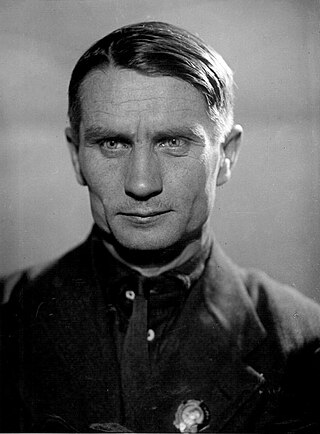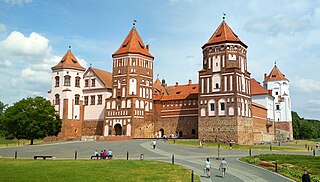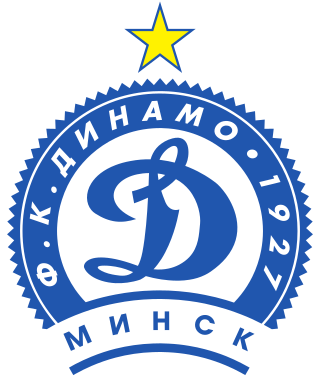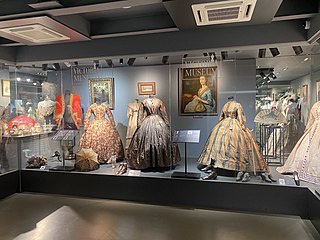
Trofim Denisovich Lysenko was a Soviet agronomist and scientist. He was a proponent of Lamarckism, and rejected Mendelian genetics in favour of his own idiosyncratic, pseudoscientific ideas later termed Lysenkoism.

Minsk is the capital and largest city of Belarus, located on the Svislach and the now subterranean Niamiha rivers. As the capital, Minsk has a special administrative status in Belarus and is the administrative centre of Minsk Region and Minsk District. As of 2024, it has a population of about two million, making Minsk the 11th-most populous city in Europe. Minsk is one of the administrative capitals of the Commonwealth of Independent States (CIS) and the Eurasian Economic Union (EAEU).

Grodno region, also known as Grodno oblast or Hrodna voblasts, is one of the regions of Belarus. Its administrative center, Grodno, is the largest city in the region. As of 2024, it has a population of 992,556.

Vitebsk region, also known as Vitebsk oblast or Vitsyebsk voblasts, is one of the regions of Belarus. Its administrative center is Vitebsk. It is located in the north of the country, and borders on Russia.

Belarus is an Eastern European country with a rich tradition of folk and religious music. The country's folk music traditions can be traced back to the times of the Grand Duchy of Lithuania. The country's musical traditions spread with its people to countries like Russia, Canada, United States, Kazakhstan and Latvia. The people of Belarus were exposed mostly to Russian pop music during this period and also after independence in 1991. In 2002, however, President Alexander Lukashenko has signed a decree requiring 50% of all FM broadcast music to be Belarusian in origin, and since 1 January 2005 the rule has been even stricter. However, it does not regulate the language of the songs, so most of the music which is broadcast is still in Russian.

FC Dinamo Minsk or FKDynama Minsk is a Belarusian professional football club based in the capital city of Minsk.

Belarusian culture is the product of a millennium of development under the impact of a number of diverse factors. These include the physical environment; the ethnographic background of Belarusians ; the paganism of the early settlers and their hosts; Eastern Orthodox Christianity as a link to the Byzantine literary and cultural traditions; the country's lack of natural borders; the flow of rivers toward both the Black Sea and the Baltic Sea; and the variety of religions in the region.

Rechytsa or Rechitsa is a town in Gomel Region, Belarus. It serves as the administrative center of Rechytsa District. The town is located on the Rechytsa River, which flows into the Dnieper. In 2020, its population was 66,400. As of 2024, it has a population of 65,213.

Tatyana Viktorovna Lysenko is a Russian hammer thrower. Her career has been blighted by repeated doping infractions. In February 2019, the Court of Arbitration for Sport handed her an eight-year ban for doping, starting from 2 July 2016.
Early East Slavs settled the forested hills of today's Minsk by the 9th century. They had been migrating from further south and pushing the preceding Balts northwards. The valley of Svislach river was settlement boundary between two Early East Slavs' tribal unions – Krivichs and Dregovichs. By 980 the area was incorporated into the early medieval Principality of Polatsk, one of the earliest East Slav states along with the principalities of Kiev and Novgorod.

Francis Skaryna Belarusian Library and Museum in north London, England, is the only library outside Belarus to collect exclusively in the field of Belarusian studies. It was formally established as an independent institution in 1971 and is owned by a charitable trust. The library — alongside the Belarusian Catholic Mission in England, Anglo-Belarusian Society and the Journal of Belarusian Studies — had a significant role in encouraging Belarusian studies in the United Kingdom and outside Belarus in second half of the 20th century.

The Vitebsk Regional History Museum is a museum in Vitebsk, Belarus.

Vladimir Ivanovich Lysenko is a Russian academic and world traveler. He set several Guinness World Records related to high-altitude river rafting.
Stary Dzyedzin is a village in Klimavichy District, Mogilev Region, Belarus. It is part of Kisyalyova Buda selsoviet. It is situated on the right bank of the Ostyor River, five kilometres (3.1 mi) north of the Ivatsevichy–Babruysk–Krychaw (P43) highway which leads to the border with Russia.

Pyotr Fyodorovich Lysenko, was a Belarusian archaeologist, Doctor of History, professor.

Independence Day of the Republic of Belarus, also known as Republic Day or Liberation Day is a public holiday, the independence day of Belarus and is celebrated each year on 3 July. Independence Day is a non-working day.

Brest Castle evolved in the course of several centuries from the Slavonic fortified settlement Berestye that had appeared at the turn of the 10th and 11th centuries at the confluence of the Mukhavets River into the Bug River, amid islands, formed by the rivers. It was re-built several times after numerous fires and sieges, was destroyed in the course of construction of the Brest Fortress in the 19th century.

Anatoly Grigorievich Lysenko was a Soviet and Russian television figure, journalist, director, producer. Honored Artist of Russia, laureate of the State Prize of the USSR. On 18 July 2012 he was appointed general director of Public Television of Russia.

The architecture of Belarus spans a variety of historical periods and styles and reflects the complex history, geography, religion and identity of the country. Several buildings in Belarus have been designated as UNESCO World Heritage Sites in recognition of their cultural heritage, and others have been placed on the tentative list.

Victoria Museum is a museum of historical costume and style in Kyiv, dedicated to the urban European fashion of the Victorian era (1850–1920). It is the first costume and style museum in Ukraine. It is equipped with the most modern requirements. A museum has a climate control system and solar filtration.



















